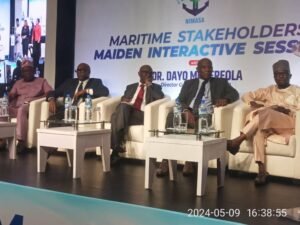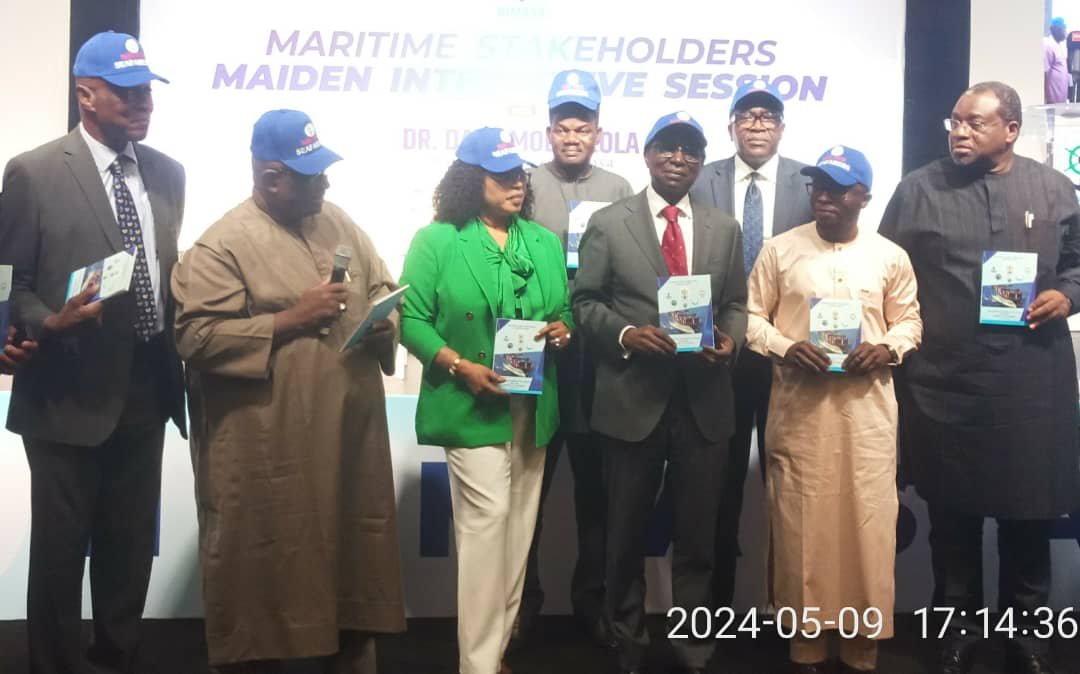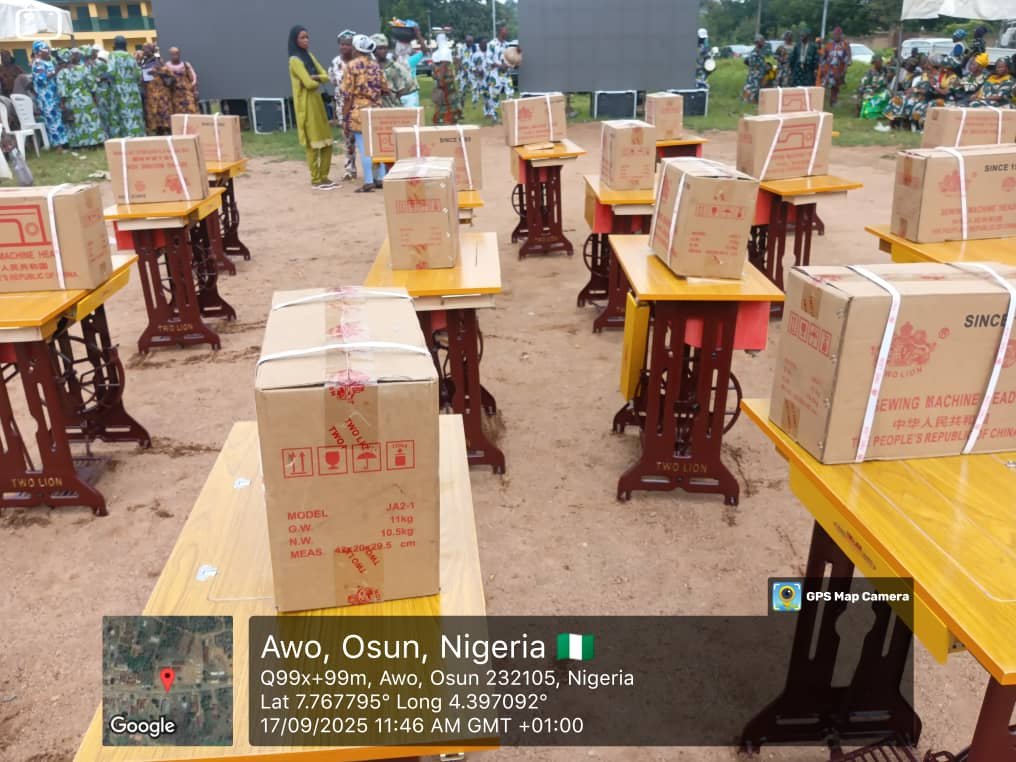Flowerbudnews
Lagos: The Maritime stakeholders had said that the country was losing $1tn annually to the non disbursement of the Cabotage Vessels Financing Fund (CVFF).
The stakeholders in the Marine and Blue Economy disclosed this on Thursday in Lagos at the Maritime Stakeholders Group Meeting with the new Director General of the Maritime Administration and Safety Agency,(NIMASA) Dr Dayo Mobereola.
In his presentation titled “Navigating to the Promise Land” A Maritime Lawyer, Emeka Akabogu, said that the country was losing $4billion to lack of local marine transportation.

(From-L-R The Executive Director Operations of NIMASA, Mr Fatai Adeyemo, Executive Director Finance and Admin. NIMASA, Mr Chidi Offodili, the Director General , NIMASA, Dr Adedayo Mobereore, Capt. Emmanuel Ihenacho, and Executive Director, Labour in NIMASA, Mr Jubril Abba,
at the Maritime Stakeholders Group Meeting with)
“There are three legs to shipping, fleet expansion, ship repairs, and , dry ducking and ship building and the country is losing $9 billion annually to the non participation in International freight services.
” The fishing sub-sector of the maritime industry contributes N282billion annually to the economy.
“Nigeria’s coastal resources have an estimated capacity of $504trillion. Current realised capacity is $106trillion in export and import on frozen fish is $876million.
“The former Director General, NIMASA, Dr Bashir Jamoh, have said that Nigeria loses approximately, $25.5bilion annually to illegal maritime activities and the Nigerian National Petroleum Corporation Limited loses, $1.35billion on oil bunkering,” Akabogu said.

(The Director General , NIMASA, Dr Adedayo Mobereore, and other Marine and Blue Economy Stakeholders presenting and launching of a book titled; Reviewed Minimum Standard for the Nigerian Seafarers held in Lagos on Thursday.)
Akabugu said that in 2024 alone, the number of registered ships in Nigeria was 4,419 with a total tonnage of, 5.8 billion.
“Summary of the valid registered vessel, 2,136 with a 4.2billion gross tonnage, invalid registered ship, 61, cabotage registered vessel, 1033, with a gross tonnage of 1.9million. The foreign-owned vessel, 18 with a gross tonnage of 125m,million ” Akabogu said.
Akabogu said that seafarers’ groups had reported (Capt. Alfred Oniye, Secretary General of the Merchant Seafarers Association of Nigeria (MSAN) saying that over 80% of our seafarers were unemployed.
He said that the discrepancy was of concerned and speaks to credibility of available data.
He lamented over poor gender representation adding that out of 6,039 seafarers on the Nigerian seafarers’ register in 2019, only 9.3 per cent which was 567 were women adding that the former DG NIMASA, Dr Dakuku Peterside had reported.

Akabogu said that only 26 out of 250 which was 10.4 per cent of the students at the Maritime Academy of Nigeria were females despite the shocking ratio been in June 2023.
He said that that Nigeria has around 30 female seafarers with a Certificate of Competency (CoC) who were unemployed, and over 50 were looking for sea time.
Akabogu said that Nigerian seafarers are poorly remunerated. For example, a Nigerian OOW earns an average of ₦150,000 (US\$600) per month, while their foreign counterpart can earn up to US\$3,000.
“The Nigerian Marine and Blue Economy
The maritime sector is potentially the largest economic sector outside of oil and gas. It is estimated that Nigeria’s untapped blue economy potential is valued at $296 billion (NIMASA, The Africa Blue Economy Alliance (ABEA)).
” Experts also estimate that our maritime sector can generate N7 trillion annually and 2 million jobs over 5 years. This is largely because of our vast marine assets of the longest coastline in West Africa, stretching over 892 Km from Badagry to Bakassi, with a total shelf area of about 42,000 km2 (UNEP, 2014).
“Our territorial sea extends from the coastline to a breadth of 12 nautical miles, the continental shelf extends about 50 miles making us one of the eight countries with a continental shelf that allows for the extension of our EEZ (Exclusive Economic Zone) from 200 miles to a further 150 miles.
” These are in addition to our nearly 4,000 Km of inland waterways,”Akabogu said.
Earlier, the Flag Officer Commanding Western Naval Command, Nigerian Navy, Rear Admiral Mustapha Hassan, said more more was required from the NIMASA management in the implementation of the Cabotage Act.
Hasaan said that the Cabotage Act had not been been effective since its enactment.
He said there was need for inter-agency collaboration in the cabotage regime to address issues of boarding and inspection of vessels, especially with the automatic identification system.
Hassan explained that there was a lot of money for Government to make in the implementation of the Cabotage Act.
He acknowledged the readiness of the Nigerian Navy to support NIMASA to treat these cases expeditiously in the next month.
A former Director General, of NIMASA, Mr Temisan Omatseye, said the agency was established with the core mandate of promoting, protecting, and providing an enabling environment for indigenous ship owners to grow their vessels.
According to him, unfortunately, the current NIMASA leadership would not be able to disburse the Cabotagr Vessel Financing Fund (CVFF).
Omatseye said that the financial regulations had go against the banking and finance institutions’ regulations.
He said that the CVFF, NIMASA was doing the risk assessment but the disbursing does not allow an outsider to do the risk assessment as it negates the law that binds the funding.
According to him, the law says there should be a CVFF and the fund is to be disbursed in line with the guidelines as issued by the Minister of Transportation and approved by the National Assembly.
Omatseye said that CVFF was established by the Coastal and Inland Shipping (Cabotage) Act 2003 adding that the fund was established to develop indigenous ship acquisition capacity, and to provide financial assistance to indigenous domestic coastal shipping operators.
The Chairman, Seaport Terminal Operators Association of Nigeria (SOTAN), Princess Vicky Haastrup, urged NIMASA to utilise the 0.5 per cent Stevedore fee to train the stevedore workers.
Haastrup said that although the terminal operates engages the stevedore with skeletal training adding that Government was in best position to engaged them in industrial training l to avoid fatalities and other accident while discharging their duties.
A Maritime Lawyer, Mr Adedoyin Afun, urged NIMASA to reduced duties on vessel acquisition to enable more vessels to registered.
In his response, the Director General , NIMASA, Dr Adedayo Mobereore, commended the efforts of the stakeholders and all the passed Director General of the administration including those that were absent.
Mobereore said that he would work towards achieving the goals of both the President and the Minister of Marine and Blur Economy and draw a four years master plan.
He promised to carry all the stakeholders along adding that his administration would look into issues of ship registering and gender inclusive
“You can be rest assured that all this points will be considered and while NIMASA will put in strategies that will be a sustainable plan for the maritime industry.
” Our today’s knowledge sharing will not be wasted and we will call on you where we need clarification to implement all the points raised.
In his vote of thanks, Elder Asu Beks, Chairman, Maritime Stakeholders Group, urged the new management of NIMASA to look into the local Content Act.
He commended the efforts of all the stakeholders as he look forward for positive outcome to the meeting. (Flowerbudnews)



